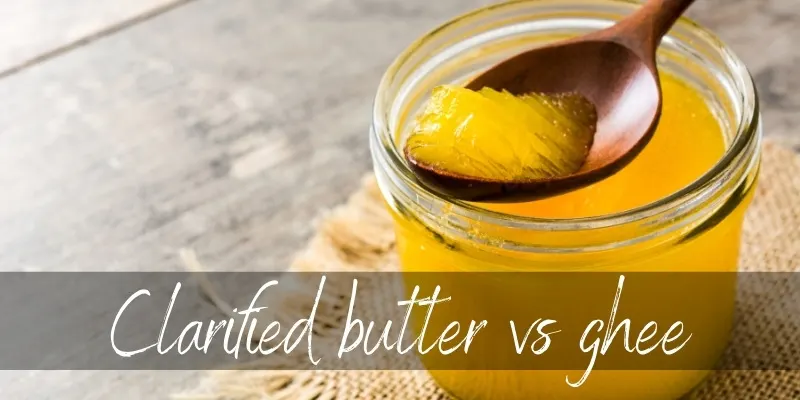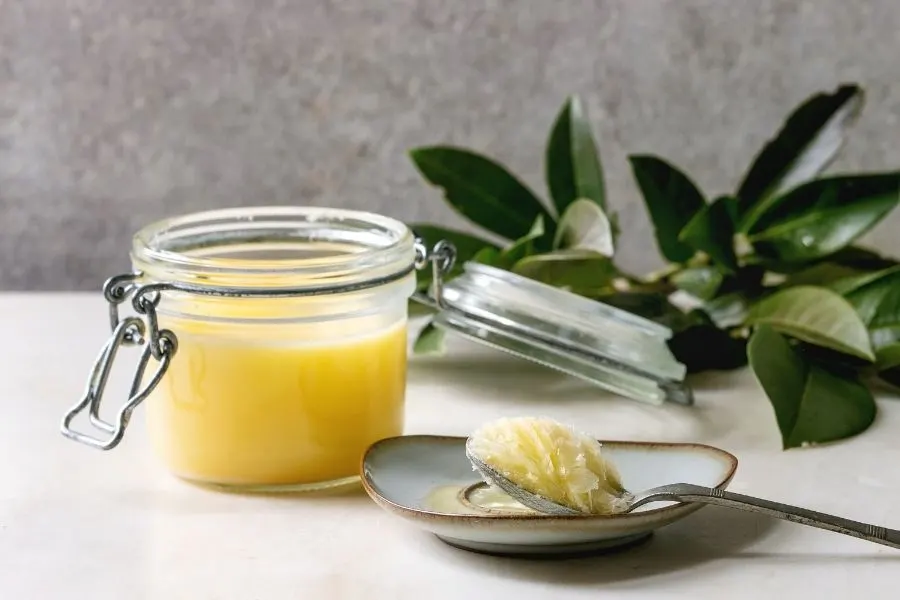In the cooking world butter has a very special place in everyone’s heart. It’s delicious, rich, and make everything better. But it burns so easily ! Fortunately, there are ways to improve upon this, and two of those ways are clarified butter and ghee.
But exactly how different are clarified butter and ghee ? Are they really that different, or simply the same food item ? And what about brown butter, where does that come in ? Let’s find out !

Clarified butter vs ghee
The main difference between clarified butter and ghee is that ghee is cooked longer than clarified butter. This results in a deeper, more intense color and flavor, because the milk solids caramelize a little. Both clarified butter and ghee strain out the milk solids.
Aside from this, they are very similar butter products and can easily be substituted for one another.
How are clarified butter and ghee made ?
When you take a look at the difference between clarified butter and ghee, you have to look at hoe both of these are made. And they’re made in the same way, but one cooks for longer. Let us explain, in case you want to make your own.
To start, you need:
- a stick of butter
- a pan to melt the butter, light colored if possible
- something to stir with
- a fine strainer or cheesecloth
- some kind of container to keep the final product
Place your butter in the cold pan, and set it on low heat. The butter will slowly melt, and will form a sort of foam on top. That is the small amount of whey leftover from production. You can let it sputter and evaporate, or spoon it off, your choice. Remember to stir !
Read also: Why Is Butter So Expensive ?
Once all the butter is melted, you should see the milk solids settling at the bottom of the pan. This is why a pan with a light color bottom will help. Now you have a choice to make:
- Stop cooking, and strain the butter into the container. You’ve made clarified butter.
- Continue cooking, on low heat. When the milk solids start to turn golden-brown, turn off the heat. Strain into a container. You’ve made ghee.
The big difference here is the amount of heat the butter is exposed to, and how much the milk solids are left to toast. Toasted milk solids mean nutty, caramel flavor, and that’s more towards ghee.
Butter’s that’s only been melted and had the foam spooned off and then the milk solids strained does not have any extra flavor. But it does have a cleaner look, and a higher smoke point.
Brown butter is a cross between the two
If you’re wondering where brown butter comes in, here it is. If you’re cooking the butter longer for ghee, you can opt not to strain the butter. That way you have brown butter, a very delicate affair. Or you can go a bit further and toast the milk solids a bit more, but this takes a very good eye and nose coordination.
Brown butter pushes butter to its limits, because you can easily turn it from toasty caramel to burnt and bitter.
Keep in mind that the whole cooked butter thing is more of a scale. You can get clarified butter that is cooked a little longer than usual, and it’s still not ghee. And you can get ghee that’s toastier than normal, and it’s still ghee if the milk solids are strained.
What do the milk solids do ?
The milk solids in all three of these butter productions are what give the butter an extra taste. This is why clarified butter, once strained, does not taste any different from regular butter. But ghee and brown butter have a deeper, caramel-like taste exactly because the milk solids end up toasting in the fat.
And it’s why brown butter can go awry to easily. Milk solids are basically tiny bits of protein, and they easily burn if subjected to too much heat. This is why you always, always have to use low heat when dealing with butter. Watch and smell what you’re cooking, don’t just time it.
Can you substitute clarified butter for ghee ?
Yes, you can substitute clarified butter for ghee and it works perfectly. Ghee is cooked a bit longer than clarified butter, but not enough to make a severe impact on the flavor of your dish. In most cases is can actually improve, if anything.
Does ghee taste like butter ?
Ghee still tastes like butter, but it has a slightly caramel-like aroma to it. Not as much as brown butter, but definitely more than clarified butter. It’s also a bit darker in color, since it’s cooked longer.

Tips on making and using clarified butter and ghee
Whenever you’re making or using clarified butter and ghee, you need to know what you’re doing. Especially when making them, because it’s much too easy to burn the whole stick of butter.
Always watch the pan, it can easily burn
Because butter can easily burn, you should always keep your eyes on the frying pan. Stir and pay attention to the smell of the butter. Only cook it on low heat if you want to make clarified butter, ghee, or brown butter. Otherwise it will cook way too fast and you’ll end up having to throw everything away.
You can safely fry with clarified butter and ghee
When you’ve removed the milk solids from the butter, its smoke point goes up dramatically. Clarified butter and ghee have a smoke point of 252 C/486 F. Meanwhile regular butter is at 175 C/350 F.
Deep frying with these is a bit of a waste, since you need so much product. But they can easily handle the oven for a roast or pie or something that needs high heat.
Use clarified butter or ghee for better sauces
The lack of milk solids in these butters makes them a great choice for many sauces. Think about it, you can sautee and even fry some ingredients, make a roux right in the pan with the butter, and then add liquid to get that perfect sauce. It will still taste buttery, maybe even better if you’re using ghee (a nuttier taste).
And that’s pretty much it, now you know the main difference between clarified butter and ghee, and even know where brown butter comes in. All three are amazing in their own way and definitely something to try out !

